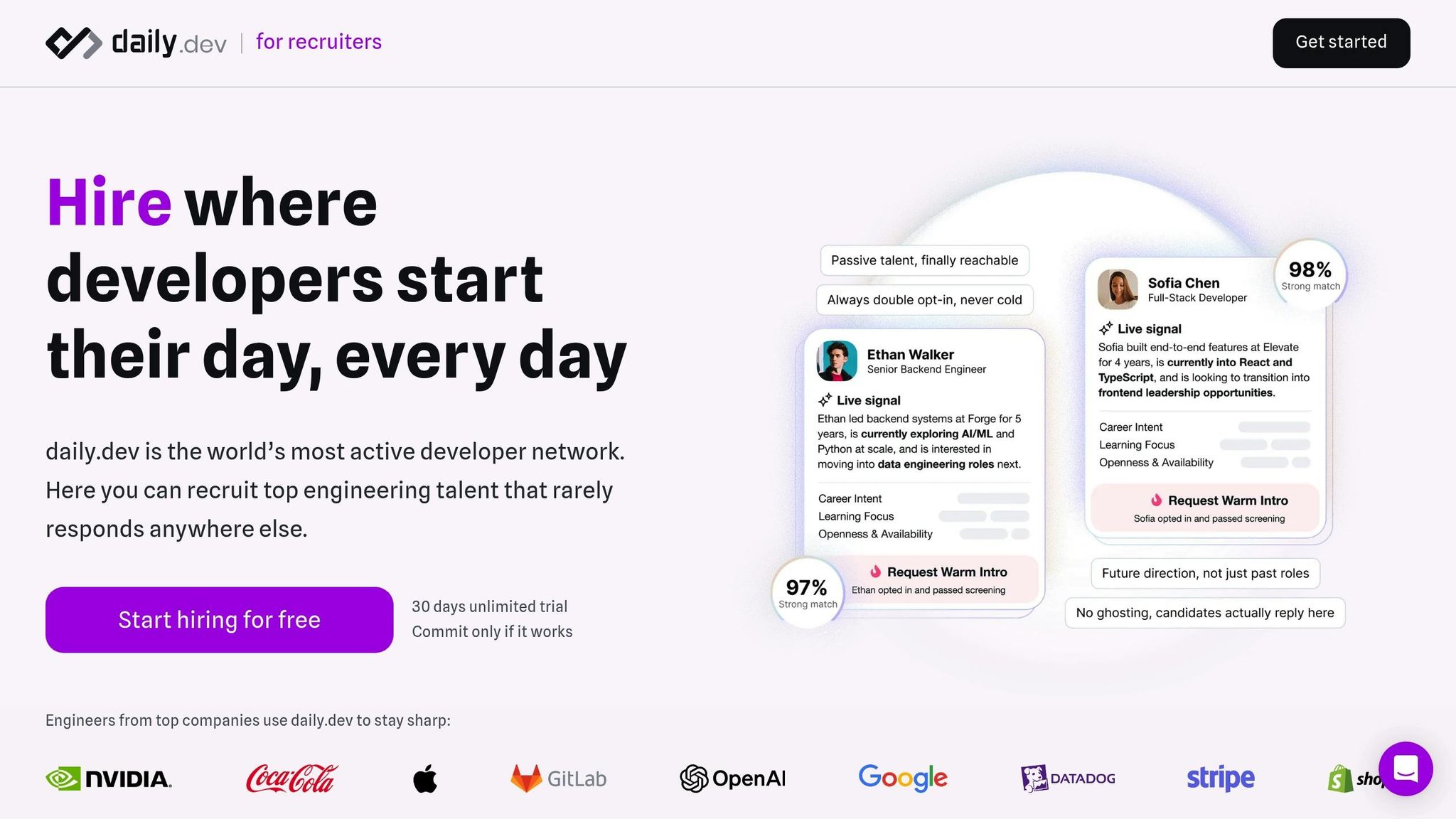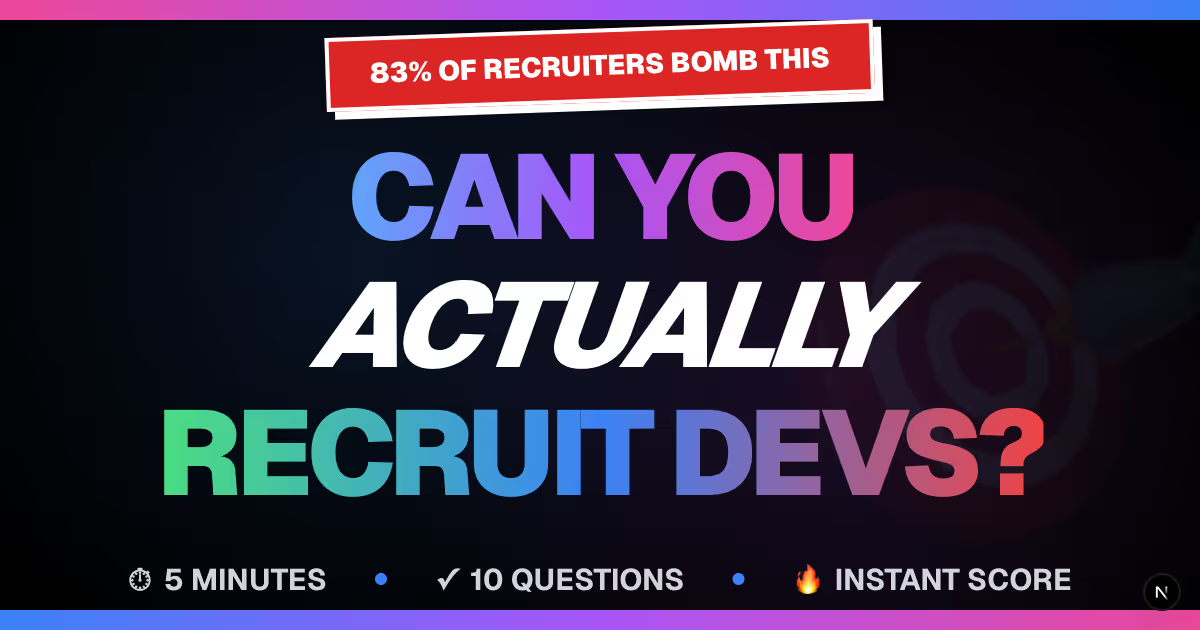


Transform your recruitment process with data-driven strategies that enhance candidate engagement and improve hiring outcomes.
Hiring developers is tough, but data-driven recruitment can simplify the process. By using real-time insights into candidates' skills and interests, you can replace outdated hiring methods with a more precise, efficient approach. Here's what you need to know:
- Why it matters: Traditional outreach methods often fail, with 90% of developers ignoring cold messages. Data-driven strategies, like warm introductions, can boost reply rates to 85-90%.
- Key metrics to track: Time to fill, cost per hire, quality of hire, source effectiveness, and candidate experience scores.
- Tools to consider: Platforms like daily.dev Recruiter analyze live developer activity, helping you connect with top talent in their professional environment.
- Improving outcomes: Use structured screening criteria, reduce bias, and monitor post-hire metrics like onboarding success and retention rates.
- Compliance matters: Ensure data accuracy and align with privacy laws like CCPA to protect candidates' rights.
This approach turns recruitment into a focused, intent-based process, saving time and connecting you with developers who are genuinely interested in your roles.
Setting Up Key Recruitment Metrics and Goals
Core Metrics for Recruitment Success
To build an effective recruitment strategy, it’s essential to track metrics that focus on efficiency, quality, and the overall candidate experience.
- Time to fill: This tracks the time between posting a job and having an accepted offer. Using warm introductions can significantly shorten this timeline.
- Cost per hire: This includes expenses like platform fees, recruiter hours, and onboarding costs. Keeping an eye on this metric helps identify areas to reduce spending.
- Quality of hire: Evaluate this by looking at new hire performance, retention rates, and feedback from hiring managers.
- Source effectiveness: Don’t just focus on the volume of applicants from different sources; instead, measure conversion rates. For instance, warm introductions often lead to better outcomes than cold applications.
- Candidate Net Promoter Score (cNPS): Use surveys to gauge how likely candidates are to recommend your hiring process. This provides valuable insight into their experience.
Once you have these metrics in place, the next step is to define clear, measurable goals that align with them.
Setting Measurable Goals
Recruitment goals should reflect your business objectives and be grounded in performance data. Start by assessing your current metrics over a relevant timeframe to establish a baseline.
"The silent killer of recruiting is mismatched expectations with hiring managers." – Nimrod Kramer
To avoid this pitfall, hold alignment sessions with hiring managers. Clearly document decisions and expectations to ensure everyone is on the same page and accountable.
Set SMART goals - specific, measurable, achievable, relevant, and time-bound. For example, aim to cut the time to fill a specific role by a certain percentage within a set number of months.
Keep market conditions in mind when setting targets. If the hiring environment is highly competitive, focus on enhancing candidate experience and ensuring high-quality hires. During less competitive periods, prioritize efficiency and cost savings instead.
Breaking annual goals into quarterly milestones makes them more manageable and allows for regular check-ins. This approach ensures your strategy stays flexible and aligned with any changes in the hiring landscape.
Regular Reviews for Continuous Improvement
Frequent reviews are key to keeping your recruitment strategy adaptable and effective. Schedule monthly meetings with stakeholders - such as hiring managers, HR leaders, and recruiters - to evaluate progress against your goals.
Create a structured agenda for these meetings. Cover topics like metric performance, emerging trends, and any bottlenecks in the process. Celebrate wins, but also dig into areas where you fell short to uncover the reasons behind them.
Quarterly reviews should take a deeper dive into areas like source effectiveness and candidate feedback. Use these insights to improve job descriptions, interview processes, and onboarding strategies.
Compare your progress against industry benchmarks and your own organizational context. Whether your focus is on speed or thorough evaluations, adjusting goals as conditions evolve is crucial. Documenting these changes and tracking their impact over time helps create a feedback loop that supports ongoing, data-driven improvements.
Webinar: How to become a data-driven recruiter
Improving Sourcing and Outreach with Data
Data takes sourcing from a game of chance to a well-oiled strategy. By analyzing which channels yield the best outcomes and tailoring outreach efforts accordingly, you can connect with developers who are genuinely interested in your roles. With clear recruitment metrics in hand, this data-driven approach ensures your sourcing and outreach efforts are precise and effective.
Analyzing Sourcing Channel Performance
Success in sourcing isn’t about how many resumes you collect - it’s about the quality of engagement. Instead of focusing on the volume of applications, look at reply and conversion rates.
Track reply rates across different channels to identify which ones spark genuine interest versus those that lead to dead ends. Dive deeper into conversion rates to see how many of these replies turn into meaningful conversations. It's also worth assessing how well candidates from each channel align with your hiring needs. Adding custom screening questions can further streamline this process, helping you pre-qualify candidates before moving forward.
Another key factor is the ability to tap into passive talent pools. Many skilled developers aren’t actively job hunting but might be open to the right opportunity. Channels that connect with this passive audience can often deliver higher-quality candidates. Keep an eye on metrics like cost per qualified introduction to ensure your budget is being spent wisely.
Creating Targeted Outreach Strategies
To cut through the noise, craft outreach efforts that resonate with developers’ skills, interests, and professional habits. Behavioral data can help you personalize your approach - think about the technologies they use, the content they engage with, and where they are in their career journey.
Timing also plays a crucial role. Analyzing when developers are most active online allows you to present opportunities at the right moment. Your messaging should reflect their unique context, emphasizing aspects that matter to them, like technical challenges, growth potential, or team dynamics. Generic job descriptions won’t cut it - developers respond better to tailored role briefs that speak directly to their interests. Tools like daily.dev Recruiter make executing these personalized strategies seamless with their warm introduction model.
Using daily.dev Recruiter for Warm Introductions

A refined sourcing strategy becomes even more powerful with daily.dev Recruiter, which transforms traditional outreach. Instead of cold messaging, the platform uses a double opt-in system - roles are shown to developers within the daily.dev ecosystem, and only those who express interest are introduced. This ensures every conversation starts with mutual engagement.
"Most platforms give you a database of profiles. With daily.dev, you get warm, double opt-in introductions from developers already engaged on our platform. It's a distribution channel powered by developer attention, not another search tool."
- daily.dev Recruiter
The platform automatically targets candidates using insights into their behavior and preferences. Developers see roles that match their skills, experience, and career goals, eliminating the need for mass outreach. This precision targeting results in better matches and more meaningful interactions.
Additionally, daily.dev Recruiter’s developer-first approach improves the candidate experience while giving recruiters access to senior talent that’s often hard to reach. Custom screening questions add another layer of refinement, ensuring candidates meet hiring criteria before introductions are made. This approach guarantees that every conversation starts on the right foot, saving time and leading to better outcomes.
Improving Screening and Reducing Bias
After setting up solid sourcing strategies, the next step is crafting a screening process that’s both fair and efficient. A data-driven approach can help you pinpoint the best candidates while addressing unconscious biases that might influence hiring decisions.
Using Structured Screening Criteria
Structured screening transforms subjective opinions into objective, measurable evaluations. Start by creating standardized scorecards to assess candidates based on key factors like technical skills, relevant experience, and interpersonal abilities. For example, you might include knockout criteria such as requiring at least three years of Python experience to quickly filter out those who don't meet the baseline qualifications.
Go beyond the generic job description and customize your criteria to reflect the specific needs of the hiring manager, the team’s dynamics, and the nature of ongoing projects. Incorporating tailored screening questions can help ensure candidates align with both the role and the team’s unique requirements.
Document your screening criteria clearly and train your team to apply them consistently. This structured approach not only improves efficiency but also helps mitigate bias.
Reducing Bias in Recruitment
Even with structured processes in place, unconscious bias can still creep in. To tackle this, consider strategies like blind resume reviews, where personal details are removed during the initial evaluation phase. Including diverse interview panels can also help balance individual biases, ensuring a more objective assessment.
Using standardized interview questions and structured behavioral interviews allows for fair comparisons between candidates. Additionally, tracking demographic data throughout the hiring process can reveal areas where bias might be influencing decisions, giving you a chance to address these issues proactively.
Auditing Screening Processes
Regularly reviewing your screening outcomes and gathering feedback from your team ensures your criteria remain effective, fair, and aligned with your goals. Continuous evaluation and fine-tuning of your process help maintain consistency and ensure you’re selecting the best candidates without compromising fairness.
sbb-itb-d1e6221
Tracking Post-Hire Metrics for Better Results
After implementing screening processes and addressing bias, it's essential to measure outcomes after hiring. These insights can help you fine-tune your recruitment strategy for better results.
Measuring Onboarding Success
One of the most telling indicators of a successful hire is time to productivity. This measures how quickly new developers contribute meaningfully - whether by shipping a feature, fixing a bug, or completing a milestone. Companies with effective onboarding processes often see such contributions within 30–90 days.
Another critical metric is early retention rates, which can reveal whether new hires are a good match for the role and company culture. Track retention at key intervals - 30 days, 90 days, six months, and one year. A noticeable increase in departures around the 90-day mark might point to mismatched expectations or insufficient onboarding support.
Additionally, monitor onboarding completion rates and the time it takes for new hires to finish their training. If certain parts of the onboarding process consistently pose challenges, it could indicate flaws in your job descriptions or interview process that failed to set clear expectations.
Measuring Quality of Hire
To assess the quality of your hires, collect performance ratings from direct managers at 90 days, six months, and one year. This data can help identify patterns tied to specific recruitment channels, enabling you to allocate resources more effectively.
Another valuable metric is manager satisfaction scores. Survey hiring managers about new hires’ technical skills, alignment with company culture, and overall contributions to team goals. Use a consistent rating scale and ask detailed questions about whether the hire met, exceeded, or fell short of expectations.
Long-term success can also be measured through internal mobility and promotion rates. Employees who grow within your organization often represent high-quality hires who found opportunities for career advancement. Pay attention to which recruiting sources and screening methods yield candidates with strong internal growth trajectories.
Using Feedback Loops for Process Improvement
New hire surveys conducted at 30, 90, and 180 days can uncover valuable insights about your recruitment process. Ask specific questions about the interview experience, the accuracy of job descriptions, and whether the role aligned with their expectations. This feedback can highlight gaps between what recruiters communicate and the actual responsibilities of the job.
To avoid miscommunication, align recruiter and hiring manager expectations. As Nimrod Kramer notes, "broken context silently undermines hiring". Regular feedback sessions between these teams can help identify and resolve any disconnects in candidate requirements.
Exit interview data is another goldmine of information, particularly from employees who leave within their first year. Understanding why promising hires decide to leave can reveal systemic issues in your hiring process or workplace culture that need attention.
Hold monthly feedback reviews with recruiting teams and hiring managers to analyze post-hire metrics. Look for trends in the data - such as whether certain interview questions predict success or if candidates from specific sources perform better over time. These insights can help refine your screening criteria and sourcing strategies.
Finally, track how daily.dev Recruiter's warm introductions correlate with long-term success. The platform’s ability to connect you with engaged, pre-qualified developers often leads to better cultural alignment and higher retention rates. These data points can be instrumental in optimizing your overall recruitment approach.
Maintaining Data Accuracy and Compliance
Accurate, secure, and compliant data plays a critical role in successful hiring, improving outcomes, and safeguarding both organizations and candidates.
Maintaining Data Quality
The backbone of data-driven hiring is reliable, up-to-date information. Traditional recruitment methods often depend on static profiles that can quickly become outdated, leading to missed opportunities or mismatched hires. Using real-time engagement data from active candidate participation keeps details current and relevant.
To further refine the process, structured screening criteria and tailored questions can help validate candidates and reduce the risk of poor hiring decisions. Integrating your applicant tracking system (ATS) is another essential step. For instance, daily.dev Recruiter highlights how seamless ATS integration eliminates manual errors, automatically deduplicates candidates, and streamlines data transfers.
Creating detailed candidate profiles that include work history, technical interests, and career aspirations provides a deeper understanding of each applicant, empowering you to make more informed decisions.
Following U.S. Privacy Regulations
Once data quality is addressed, compliance becomes the next focus. Adhering to U.S. privacy laws, such as the California Consumer Privacy Act (CCPA), is crucial. The CCPA gives individuals rights like knowing what data is collected, requesting its deletion, and opting out of data sales. Providing clear and accessible privacy notices that outline your data collection, usage, and sharing practices ensures transparency.
Although the General Data Protection Regulation (GDPR) is a European framework, its principles - like obtaining explicit consent and enabling data portability - offer valuable guidance for best practices. Additionally, new state-level privacy laws emphasize the importance of clear data retention policies and robust consent management throughout the recruitment process.
Running Regular Data Audits
Regular audits are key to maintaining both data accuracy and compliance. These reviews help identify errors, ensure alignment with changing legal requirements, and keep operational practices on track. By routinely auditing your recruitment data, you can maintain a clean, dependable database that supports effective hiring decisions while reducing potential risks.
Your Path to Data-Driven Recruitment Success
Data-driven recruitment is reshaping how developers are hired by offering real-time insights into their skills, interests, and career goals. Instead of relying on outdated profiles or impersonal cold outreach, this approach focuses on building meaningful connections, leading to better hiring results. It shifts the emphasis from chasing volume to engaging with candidates in a way that truly matters.
Traditional recruitment methods often face challenges like low response rates and time-consuming screening processes. A data-driven strategy removes much of the guesswork, attracting candidates who are genuinely interested in the role. This approach opens doors to talent pools that are often inaccessible through conventional methods, giving you a competitive edge.
What makes this method stand out is its ability to match candidates based on their current technical interests and career aspirations - not just keywords on a resume. Custom screening criteria ensure candidates meet specific needs, even those not explicitly stated in job descriptions. This reduces the time wasted on unqualified applicants and keeps the process efficient.
Beyond precise matching, robust integrations play a key role in streamlining the recruitment process. Features like seamless ATS integrations and automated deduplication simplify workflows and improve data accuracy, all while minimizing manual effort. This makes your recruitment process not only faster but also more informed and effective.
For developers, this approach enhances their experience. Recruitment becomes more transparent and personalized, offering opportunities that align with their goals. Instead of irrelevant cold emails, candidates engage in meaningful conversations about their careers, building trust and strengthening your employer brand.
Active professional communities also provide valuable insights into developer preferences and market trends, ensuring your recruitment strategies stay relevant. By combining these insights with a data-first mindset, you can transform your hiring process into a well-oiled machine.
Ultimately, success hinges on using platforms that prioritize accurate data, compliance, and genuine engagement with developers. With the right tools - offering proprietary insights, warm introductions, and seamless integration - you can create a recruitment process that benefits both your team and the candidates you engage with.
FAQs
How does data-driven recruitment enhance the candidate experience and foster better engagement?
Data-driven recruitment transforms the hiring process by emphasizing personalized and meaningful interactions. Instead of generic approaches, it focuses on meeting developers where they naturally spend their time - whether that's reading, learning, or engaging within their professional communities. This creates a more seamless and relatable experience for candidates.
Platforms adopting this method rely on trust-based connections, using warm, double opt-in introductions. This ensures developers only engage with opportunities they're genuinely interested in, eliminating unwanted or irrelevant outreach. By prioritizing high-context, intent-driven interactions, the process becomes smoother and more rewarding for both recruiters and candidates.
What should recruiters know about ensuring data accuracy and privacy in a data-driven hiring process?
To maintain accuracy and protect privacy in a data-driven recruitment process, recruiters should pay close attention to several important areas:
- Keeping data accurate: Make it a habit to regularly review and update candidate information. This ensures details are up-to-date and useful. Stick to trustworthy sources and avoid relying on incomplete or outdated profiles.
- Respecting privacy laws: Follow relevant data protection regulations like GDPR or CCPA, depending on your location. Always get clear consent from candidates before collecting or storing their information, and use it strictly for hiring purposes.
- Securing sensitive data: Use encrypted systems to store candidate information and restrict access to authorized personnel only. Take strong cybersecurity measures to guard against breaches.
Focusing on these practices helps build trust with candidates while ensuring your recruitment process stays compliant and efficient.
What are the best post-hire metrics to evaluate the success of a recruitment strategy?
To gauge how effective your recruitment strategy is in the long run, it's essential to focus on post-hire metrics that reveal the lasting results of your hiring choices. Here are a few key indicators to consider:
- Employee Retention Rate: This tracks how many of your new hires remain with the company after a set period, like 6 months or a year. A strong retention rate often signals that the new employees are well-suited for their roles and the company culture.
- Time to Productivity: This measures how quickly new hires can perform at full capacity in their positions. If the ramp-up time is relatively short, it’s a good sign that your onboarding process and hiring decisions are working well.
- Quality of Hire: Evaluate how new employees perform relative to expectations. This could involve manager evaluations, performance reviews, or tangible results tied to their responsibilities.
Regularly reviewing these metrics can help you fine-tune your hiring approach, leading to better results for both your team and the individuals you bring on board.
Related Blog Posts








